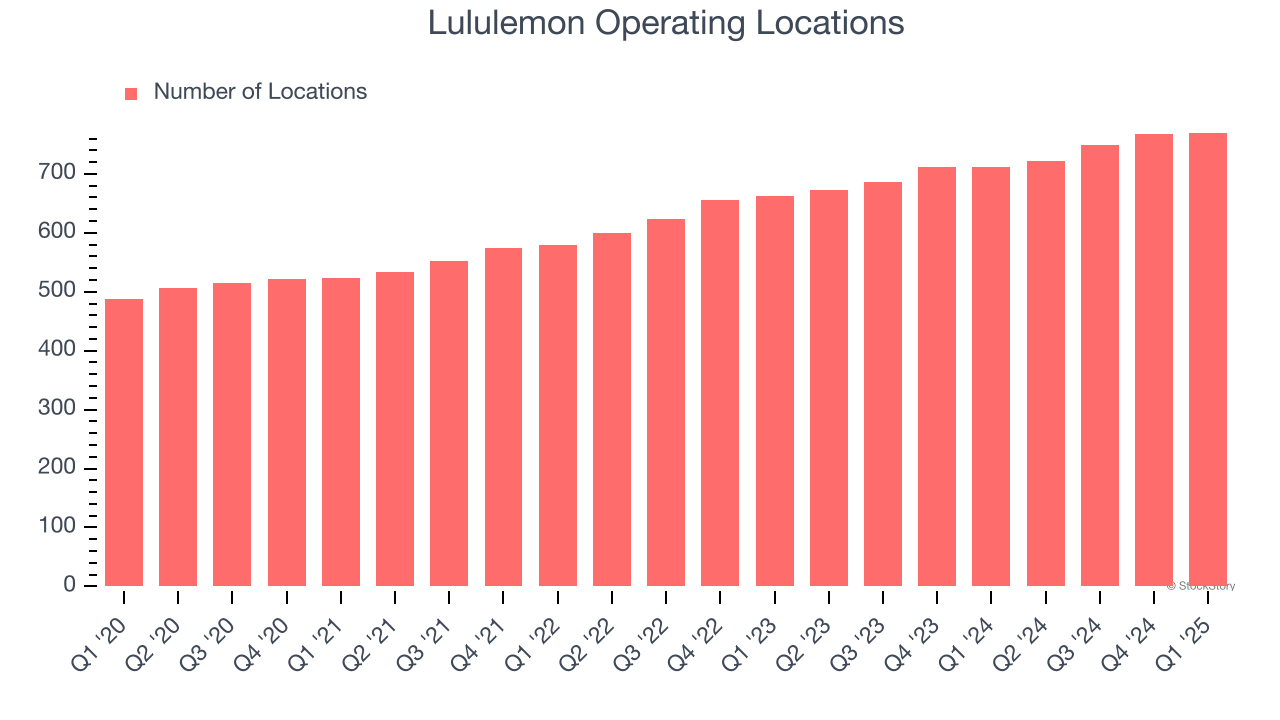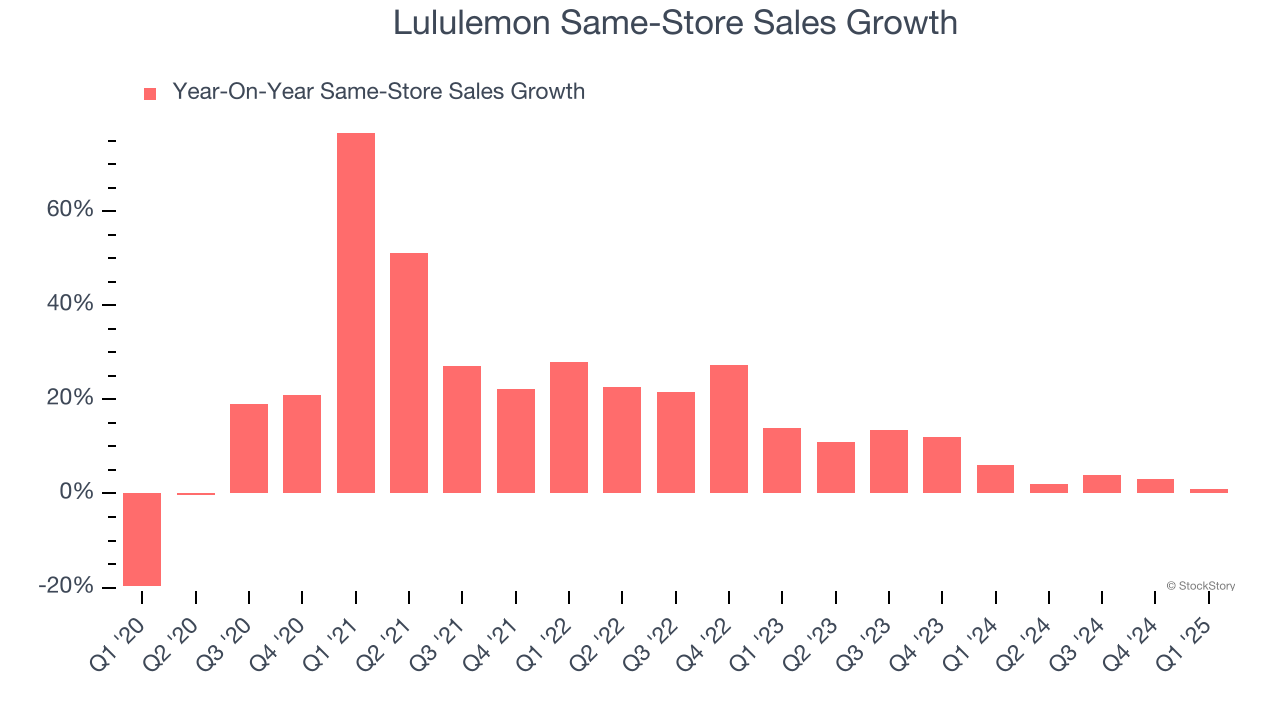
Athletic apparel retailer Lululemon (NASDAQ:LULU) met Wall Street’s revenue expectations in Q1 CY2025, with sales up 7.3% year on year to $2.37 billion. On the other hand, next quarter’s revenue guidance of $2.55 billion was less impressive, coming in 0.7% below analysts’ estimates. Its GAAP profit of $2.60 per share was in line with analysts’ consensus estimates.
Is now the time to buy Lululemon? Find out by accessing our full research report, it’s free.
Lululemon (LULU) Q1 CY2025 Highlights:
- Revenue: $2.37 billion vs analyst estimates of $2.37 billion (7.3% year-on-year growth, in line)
- EPS (GAAP): $2.60 vs analyst estimates of $2.59 (in line)
- The company reconfirmed its revenue guidance for the full year of $11.23 billion at the midpoint
- EPS (GAAP) guidance for the full year is $14.68 at the midpoint, missing analyst estimates by 1.8%
- Operating Margin: 18.5%, down from 19.6% in the same quarter last year
- Locations: 770 at quarter end, up from 711 in the same quarter last year
- Same-Store Sales rose 1% year on year (6% in the same quarter last year)
- Market Capitalization: $40.27 billion
Company Overview
Originally serving yogis and hockey players, Lululemon (NASDAQ:LULU) is a designer, distributor, and retailer of athletic apparel for men and women.
Sales Growth
Examining a company’s long-term performance can provide clues about its quality. Even a bad business can shine for one or two quarters, but a top-tier one grows for years.
With $10.75 billion in revenue over the past 12 months, Lululemon is a mid-sized retailer, which sometimes brings disadvantages compared to larger competitors benefiting from better economies of scale. On the bright side, it can still flex high growth rates because it’s working from a smaller revenue base.
As you can see below, Lululemon grew its sales at an exceptional 21% compounded annual growth rate over the last six years (we compare to 2019 to normalize for COVID-19 impacts) as it opened new stores and increased sales at existing, established locations.

This quarter, Lululemon grew its revenue by 7.3% year on year, and its $2.37 billion of revenue was in line with Wall Street’s estimates. Company management is currently guiding for a 7.4% year-on-year increase in sales next quarter.
Looking further ahead, sell-side analysts expect revenue to grow 6.3% over the next 12 months, a deceleration versus the last six years. We still think its growth trajectory is attractive given its scale and implies the market is baking in success for its products.
Software is eating the world and there is virtually no industry left that has been untouched by it. That drives increasing demand for tools helping software developers do their jobs, whether it be monitoring critical cloud infrastructure, integrating audio and video functionality, or ensuring smooth content streaming. Click here to access a free report on our 3 favorite stocks to play this generational megatrend.
Store Performance
Number of Stores
A retailer’s store count often determines how much revenue it can generate.
Lululemon sported 770 locations in the latest quarter. Over the last two years, it has opened new stores at a rapid clip by averaging 8.8% annual growth, among the fastest in the consumer retail sector. This gives it a chance to become a large, scaled business over time.
When a retailer opens new stores, it usually means it’s investing for growth because demand is greater than supply, especially in areas where consumers may not have a store within reasonable driving distance.

Same-Store Sales
The change in a company's store base only tells one side of the story. The other is the performance of its existing locations and e-commerce sales, which informs management teams whether they should expand or downsize their physical footprints. Same-store sales gives us insight into this topic because it measures organic growth for a retailer's e-commerce platform and brick-and-mortar shops that have existed for at least a year.
Lululemon has been one of the most successful retailers over the last two years thanks to skyrocketing demand within its existing locations. On average, the company has posted exceptional year-on-year same-store sales growth of 6.6%. This performance suggests its rollout of new stores is beneficial for shareholders. We like this backdrop because it gives Lululemon multiple ways to win: revenue growth can come from new stores, e-commerce, or increased foot traffic and higher sales per customer at existing locations.

In the latest quarter, Lululemon’s same-store sales rose 1% year on year. This was a meaningful deceleration from its historical levels. We’ll be watching closely to see if Lululemon can reaccelerate growth.
Key Takeaways from Lululemon’s Q1 Results
It was good to see Lululemon narrowly top analysts’ gross margin expectations this quarter. On the other hand, its EPS guidance for next quarter missed and its full-year EPS guidance fell short of Wall Street’s estimates. Overall, this quarter could have been better. The stock traded down 15.5% to $279 immediately following the results.
Lululemon didn’t show it’s best hand this quarter, but does that create an opportunity to buy the stock right now? What happened in the latest quarter matters, but not as much as longer-term business quality and valuation, when deciding whether to invest in this stock. We cover that in our actionable full research report which you can read here, it’s free.
